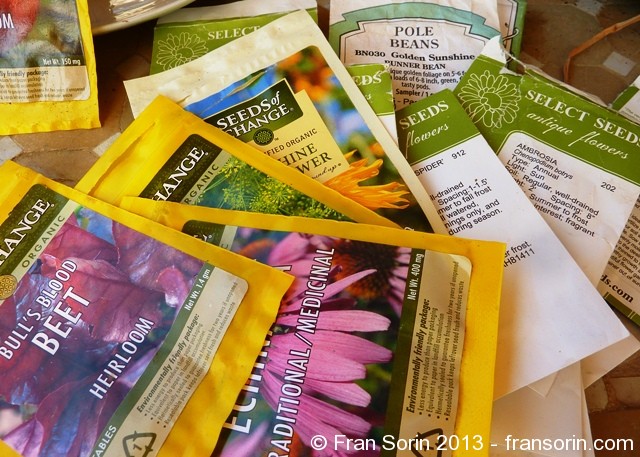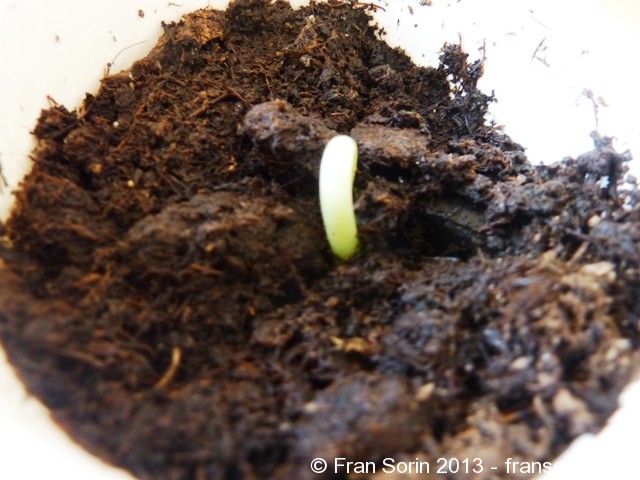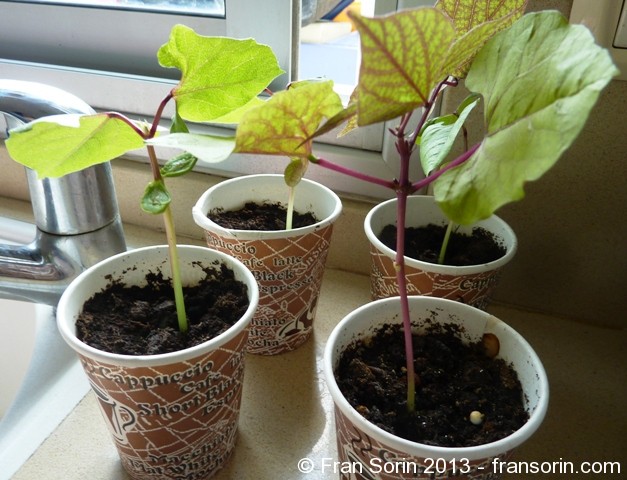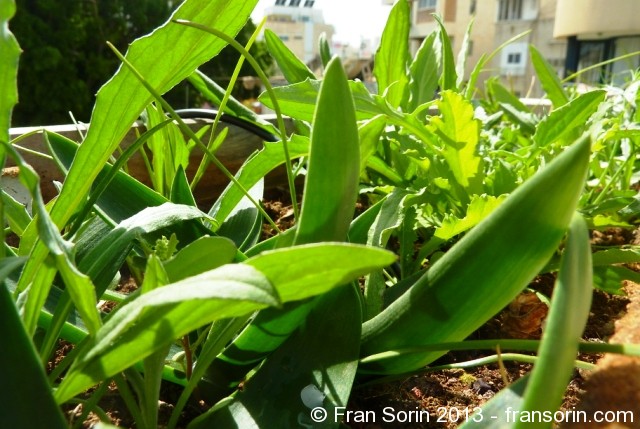The very act of planting a seed in the earth has in it to me something beautiful. I always do it with a joy that is largely mixed with awe. Celia Thaxter
The process of germinating seeds is magical.
It starts each January when my garden is covered with snow and working in the yard feels like a distant memory. I go online, download seed catalogs, and dreamily click on page after page. Envisioning what the seeds from each packet will become, I see the colors, smell the scents, and touch the leaves. I make a wish list of specimens that catch my eye. I feel extravagant as I begin to tally up the cost of my order. But then I remind myself that the cost per plant is so minuscule that it would be criminal not to buy them.
Once the seeds arrive, the preparation begins.
Here are some tips on what to do ~
1. Wash and sanitize all containers (a dab of bleach in soapy water does the trick).
2. Separate the seed packets into piles based on the time needed to reach maturity, whether they are early or late sowers, and whether you plan to sow the seeds directly outside or get a head start by sowing indoors in early spring. (If you sow them indoors, then take them out to the garden as fledgling plants — usually four to eight weeks later, after any chance of frost has passed — the blooms will appear weeks or even months earlier.)
3. Use a window with a Southern exposure to germinate sun-loving seeds such as cucumbers, peppers, tomatoes, cosmos and sunflowers. Just move the seeds away from the windows at night or put newspaper between the window and the seeds to ward off the cold. To maintain high humidity, either cover the container with a plastic bag or use the clear plastic domes sold with sowing flats.
4. Rig up a germinating room using fluorescent lights. A few years ago, I bought 12 fluorescent lighting fixtures, each 4 feet long. I attached them to 2-by-4-inch pieces of wood that are about 8 feet long and hung from chains; that way, the height of the lighting unit can be adjusted as the seeds turn into seedlings and, eventually, plants. This system gives the seeds the optimal 14 to 16 hours of light per day. Keep the lights 2 inches above the pre-germinated seeds, and when they become seedlings, raise the lights to 4 inches. I set up this system in my basement, but you can use any room in the house.
5. Buy a sowing medium that is specifically for seeds – the package will be labeled “seed starting mix”. Fill the containers to the top with it, tamp down to compress the feather-like texture, and then add more sowing mix to bring it to the top again.
6. Plant number of seeds in one container based on their size. With large seeds such as sunflowers and sweet peas, limit yourself to two or three in a 2-by-2-inch container; with tiny poppy and nicotiana seeds, you can sprinkle in a dozen. Simply press larger seeds into the soil until they’re slightly covered; sprinkle smaller seeds on top of the soil. Then water the containers from the bottom and cover with a plastic dome or bag to conserve humidity.
At its essence, the Zen of germinating seeds is about taking delight in all of the rituals of selecting, ordering, preparing, planting, tending and then waiting. When all the seeds are sown, I pause and give thanks. It reminds me of when I used to tuck my children under the covers and feel that all was good and right in the world.
Soon I see that what was a dormant seed has nuzzled its way through the earth and sprouted into a green stem with two leaves ready to unfurl, and I’m filled with a sense of wonder. No matter how many years I do it, I always have an emotional response to this life-affirming process.
SOME SEEDS THAT I GERMINATE (this in no way excludes the dozens of others that I use in my garden)
Sweet Pea ‘Cupani’s original’
Tarahumara, Autumn Beauty, Giant Primrose, Giant White Seeded, and Hopi Black Dye Sunflower ( I germinate several varieties)
Bouquet Dill
Bull’s Blood Beet
Japanese Giant Red Mustard
Pole Runner Bean – Golden Sunshine
Rhubarb Chard
Red Calabash, Paul Robeson and Beefsteak Tomato ( I germinate several varieties)
Zinnia ‘Red Spider’ (I germinate several varieties)
SEED SOURCES THAT I USE
NOW IT’S YOUR TURN. Does germinating seeds in soil have a special meaning for you? What varieties do you germinate?





Fran,
You have me very excited for Spring!! I just planted a little herb garden with basil, chives, rosemary, parsley and thyme. (not from seeds) I just found out that we will be moving soon and I will not be able to plant a spring garden. So instead I am planting containers with lettuce, spinach and other spring veggies. I love this time of year and feel very zen in my garden, connecting with the earth. When my children were small, they helped me with the planting. These were some of the best times that we had together. My new garden will be quite small, with many containers. I am looking forward to this time as my life changes and my style of gardening changes, too.
Great post!!
xoxo
Betsy
Betsy-
Congratulations on your move. I can imagine you in the garden planting up specimens with loving care. You can grow anything in containers ~ I’m sure you know that lettuce are mostly a cool crop- which means you can sow the seeds sooner rather than later. A lot of my friends are so attached to their plants that when they move, they dig them up and re-plant at their new home. I think you’re going to have a blast with container gardening ~ if you need any help, let me know. Fran
Great ideas here, Fran! I will have to try germinating seeds more often. I’ve done it a few times, but usually buy the small plants. I will be starting my garden later this year. It will be mainly large pots, but I do have a shaded section in front of my house that will need some work. Always fun to think about what new plants to use. Is it too late to germinate in late April/early May? Thanks for your resource list. I will keep that for future use.
Cathy – Now is a great time to germinate. Depending on where you live, you can germinate inside or out. You live in a warm climate, yes? I don’t know what size your containers are but if they’re a good size, it might be fun to make sow a few sunflower seeds in the center of the pot to make them a focal point. Also, you still have time to buy some annual flowering vines that you can sow immediately into the soil – not indoors. I love them draping over the sides of the container – very dramatic. As far as you shade area, not as easy as sun. You might want to think about buying some plants this spring ~ I’ll have to sit on this one -Fran
Hang lights from chains to ease raising them as the plants grow. Keep lights no more than 4 inches above the tops of your seedlings: as close as 2 inches is ideal. Lack of light is the major cause of elongated, skinny stems. Plants need 12 to16 hours of light daily, but don’t leave the lights on continuously, as many plants need some dark period each night to develop properly. A simple timer can be part of the set-up.
Brenton –
Thanks for that important piece of information. In my last home, I had a whole system (home made) rigged up in the basement that allowed me to do just what you suggested – and had great success for several years.